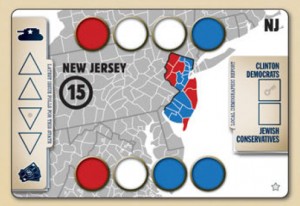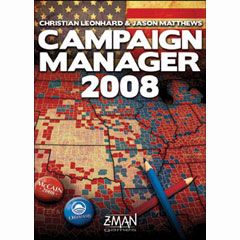Review: Campaign Manager 2008
Posted by James (admin) on August 27th, 2010
 Campaign Manager 2008 is a card-driven game recreating the Presidential Election between Obama and McCain. The designers of the game are well-known for Twilight Struggle and 1960: Making of the President – both are card driven strategy games and Twilight Struggle is ranked the number 3 best board game of all – so the game was highly anticipated.
Campaign Manager 2008 is a card-driven game recreating the Presidential Election between Obama and McCain. The designers of the game are well-known for Twilight Struggle and 1960: Making of the President – both are card driven strategy games and Twilight Struggle is ranked the number 3 best board game of all – so the game was highly anticipated.
The game primarily consists of 45 cards for each player, a deck of Breaking News cards, a mini-board for each state. Players aim to win the electoral votes of each state and be the first player to gain 270+ votes. During the game, 4 states boards are laid between the players which are the ones the players are currently campaigning (fighting) over to win. Each state has a track showing whether economy or defence is currently the important issue to its voters, and each state has two demographic groups printed on them with a marker showing which is currently the most influential group in that state.
The most important part to any state are the voters. Each state has two sets of voter tracks – one track for each Issue (defence and economy). The voter markers are circles coloured red, white or blue – these colours show where the voters loyalties lay before any campaigning. During the game, players will play cards to place their coloured discs on these circles (potentially removing their opponent’s too) which shows the support that player in that state. (White circles represent undecided voters and some cards allow players to turn them all their colour.)
 This shows red adding a support marker to a voter track: Placing a red disc over a blue circle,
This shows red adding a support marker to a voter track: Placing a red disc over a blue circle,
removing a blue marker to uncover a red circle or replacing a blue marker.
A player wins a state as soon as all of the voter circles are coloured their colour on the voter track which is currently the main issue. So, having the defence voter track all your colour doesn’t win you the state if the issue marker shows economy is the main issue. When a player wins a state, the state is removed and the player wins the amount of votes it is worth. If neither player has won the game yet, a new state is selected to replace the one just removed and a Breaking News card is turned over which have various different events.
As this is a card driven game, the cards are the heart of it. Players start with 3 cards and, on their turn, can either play a card or draw a card. The cards have various effects but most affect the situation in one or more of the 4 states in play. Many allow a player to gain support (change voters to their colour) but often only when specific conditions are met like ‘where defence is the main issue’, and so on. Some cards manipulate a state or states like moving the Issue marker towards one issue or the other, or changing which demographic groups are the most influential. Some cards allow a player to draw more cards and so on.
However, a player only ever plays with a deck of 15 cards out of the 45 for each side. At the start of the game, the players go through their deck of 45, draw 3 cards at a time, selecting only one of those three to go into the deck they will use in the game. Some cards are marked with a star highlighting which cards to use as a beginner’s deck. Also some cards allow a player to ‘Go Negative’ which makes them more powerful but a die is rolled and a chart determines the outcome which is often in the favour of the other player – so this is a power boost but at the risk of a bonus for your opponent.
 Overall, I really like the games the designers have made in the past, especially Twilight Struggle, so I was very keen to get this game. After playing it a bit, I think there are some good and some bad points.
Overall, I really like the games the designers have made in the past, especially Twilight Struggle, so I was very keen to get this game. After playing it a bit, I think there are some good and some bad points.
On the good side, Campaign Manager 2008 is a different, fast and tactical two-player game which has a lot of interaction because you’re constantly in a tug-of-war over the 4 different states and always trying to achieve your goal with your cards while the other player often undoes what you were trying to set-up. The core of the gameplay feels like it’s about timing – it usually takes a few cards to win a state and you usually only play one each turn so you want to be ready to chain a few together and win a state; however, if you wait too long your opponent may beat you to it, or change a state in a way that means your cards can’t have the effect they could have done. So, striking quickly but not going off too early is really important which makes for some difficult (and interesting) decisions. Plus, there’s a lot of tension when you’re waiting to find out if opponent is going to counter what you’re trying to achieve. Also, whilst there are a lot of different cards, they’re easy to understand (full text on each card) and it’s easy to get used to the different types quickly. The theme works well and the cards each have a photo from the actual event on them which is a nice touch. Last, but not least, the scoreboard uses card rectangles for each state (red one side, blue the other) which are proportionate in length to the amount of votes the state is worth – so these get laid end-to-end on the scoreboard to show who is ahead (rather than have to add up the totals as you go).
On the downside, the key item for me is that I haven’t felt fully involved in the strategic choices. I’ve felt a bit like the order of the cards in my deck are as much in charge of my strategy as I am because the cards have quite specific effects; thereby, limiting your options. For example, you might have cards that affect demographics not present, or need to add support but only have cards relating to issue changes. Also, it’s difficult to prepare against your opponent’s actions. If you’re close to winning a state you know they are likely to try and stop you, and you hope they can’t counter your actions. I did feel I was making choices and trying to find ways to manipulate states with the cards in hand but just not as much as I hoped given the designers’ other games.
Constructing your deck of 15 cards is interesting as it’s simple and allows a player to shape their strategy. It is essential for your cards to work together though, especially with so few. I totally recommend using the starter deck on your first play or two. I constructed a deck in my first game (my opponent had played before) and it was a disaster as I didn’t understand how the cards would work together resulting in my being able to affect the states but not gain much support to win them. I would have liked several different suggested decks (rather than just the starter one) so I could try out some good mixtures without having to learn the game in depth first. As I haven’t constructed many decks I can’t really comment on how much that aspect can affect the balance of a game.
I like the ‘Going Negative’ aspect because it tempts players but the dice can unbalance it. In one game, my opponent kept rolling the result that meant I got no benefit, whereas my rolls always benefited him. It was unfortunate but a shame it couldn’t be slightly more balanced, like instead of nothing you get a +1 or +2 chip which you can add to your opponent’s next roll ensuring that a negative campaign will always catch up with a person in the end.
The scoreboard makes it so much easier to track the increasing totals and see who is ahead. However, the card shapes for each state need to be trimmed with a knife or scissors because the spurs/tags/flash (y’know, the bits of the tokens that were connected to the frame when they were punched out) are on the ends of each piece meaning they’re not completely flush with each other so comparisons are a bit unreliable. Still, trimming them isn’t much of a big deal – just a shame those tags weren’t on the sides of the tokens and not on the ends.
Overall, I have mixed feelings about Campaign Manager 2008 – it’s good but not as obviosuly good as I had hoped out of the box. I like some aspects of it and I think it may get better as I get to know the cards more and understand how to get the most out of them. I hope that that will help me feel a bit more in charge of my actions.
James
[Played with 2 players]
removing a blue marker to uncover a red circle or replacing a blue marker.

